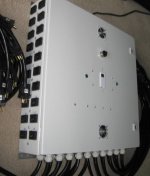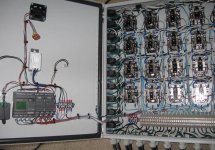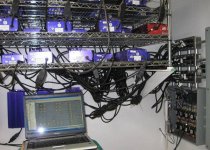-
Happy Birthday ICMag! Been 20 years since Gypsy Nirvana created the forum! We are celebrating with a 4/20 Giveaway and by launching a new Patreon tier called "420club". You can read more here.
-
Important notice: ICMag's T.O.U. has been updated. Please review it here. For your convenience, it is also available in the main forum menu, under 'Quick Links"!
You are using an out of date browser. It may not display this or other websites correctly.
You should upgrade or use an alternative browser.
You should upgrade or use an alternative browser.
62,000 watt Coco grow.
- Thread starter VagPuncher
- Start date
great work on the lectrical Tactician but I'm wondering why all the installations I've seen so far have went through the PIA receptacle route ??
If these are dedicated grows why not chop the ends off the ballast supply lines and wire them all to enclosed terminal blocks that are fed by timer boxes ??
so much easier to with terminal strips ,you can feed em with relays and a trigger timer
as well easily .
I'm thinking since you're using mag ballasts and the power supply cords are not plug n play like digis must be your reasoning ??
quick n easy ballast swap if one takes the piss...
If these are dedicated grows why not chop the ends off the ballast supply lines and wire them all to enclosed terminal blocks that are fed by timer boxes ??
so much easier to with terminal strips ,you can feed em with relays and a trigger timer
as well easily .
I'm thinking since you're using mag ballasts and the power supply cords are not plug n play like digis must be your reasoning ??
quick n easy ballast swap if one takes the piss...
Next time I am in Canada and I see a big log building... I will be thinking of massive indoor gardens..
"Even at a young age when Little Jonny started smoking pot, he still played with his Lincoln Logs"

"Even at a young age when Little Jonny started smoking pot, he still played with his Lincoln Logs"
O
OrganicOzarks
These three cans supplied all the power for the 250 lights. The grid then fed power to the three 500A disconnects. There was a total of 12 AC units, all mounted about 10 feet high in a plenum. It was much better to have the AC units elevated, then to install a ton of ductwork.
Getting old school, and growing in log cabins.
he just uses those logs to frame out his electrical room..........Go BIG or go home.
.
.
The grow was located in a building that was built specifically for the 250 lights. The main electrical was located in a small log building. Had to install smoke and fire detectors and the electrical inspector liked the small winch that was wired to the fuse-link disconnector. The winch will turn on for a couple seconds and pull the cutout, so all the power from the primary is off. The winch was wired to several sensors that if activated, will shut off all the power to everything. I can't post pics of the building because client said no way...lol
great work on the lectrical Tactician but I'm wondering why all the installations I've seen so far have went through the PIA receptacle route ??
If these are dedicated grows why not chop the ends off the ballast supply lines and wire them all to enclosed terminal blocks that are fed by timer boxes ??
so much easier to with terminal strips ,you can feed em with relays and a trigger timer
as well easily .
I'm thinking since you're using mag ballasts and the power supply cords are not plug n play like digis must be your reasoning ??
quick n easy ballast swap if one takes the piss...
The client wanted it wired that way, all the ballasts were wired for 240V and have 240V style plugs. Terminal blocks is a good idea if there are no plugs or receptacles.
FreedomFightr
Member
Holy shit man. That's some impressive shit. On another level bro
Thanx for the comps. Here are a few more controllers, a 20 ballast flip with a PLC and several options. The panel was for 48 ballasts and connected to a laptop.
Attachments
blockhead411
Member
VPuncher I like your setup. Which is better in your opinion? Bare bulbs or reflectors? Also in one of your pics I noticed that a few of the bulbs arent on. Do you have it set up so not all of the bulbs run all of the time? Because Ive read somewhere that the plant can only use so many hours of light, something like 8 out of 12 hours or something like that.
shrpshooter
Member
Absolutely stunning VAG ...STUNNING .....@ tactician those flip boxes look like the beez kneez...shrpshooter
Purplestuffed
Member
Vagpuncher some sick posts bro, i bet you came a long ways mad props and respect that there are still guys like you doing big things with a small crew niiiiice.
Thanx Shrpshooter, the PLC (programmable logic controller) makes it possible to switch 1 oe 2 lights at a time, with delays from 1/100 second to minutes, it's all programmed into the PLC. You can also select both rooms to do an 18/6 veg cycle. For 18 hours of on period, both rooms each get 6 hours of all the lights on, and the other 12 hours, the lights rotate with only half on per side, but those lights switch 1 at a time about 5 minutes apart.
A link cable is available to power of each ballast when a flip cycle is required. The ballasts can be powered off for a few seconds or several minutes, all programmable.
These things are expensive, but I've noticed the electrical and fire inpsectors I work with HATE cap, powerbox, horticontrol, lightspeed, pretty much any OTS controllers. They always ask why doesn't the onsite electrican just built to suit the needs of the grower, from breaker sizes and selection, to running cable/conduit. Mount loadcenter, receptacles, nema boxes, etc and run conduit between, then it looks nice and neat.
A link cable is available to power of each ballast when a flip cycle is required. The ballasts can be powered off for a few seconds or several minutes, all programmable.
These things are expensive, but I've noticed the electrical and fire inpsectors I work with HATE cap, powerbox, horticontrol, lightspeed, pretty much any OTS controllers. They always ask why doesn't the onsite electrican just built to suit the needs of the grower, from breaker sizes and selection, to running cable/conduit. Mount loadcenter, receptacles, nema boxes, etc and run conduit between, then it looks nice and neat.
Thanx Shrpshooter, the PLC (programmable logic controller) makes it possible to switch 1 oe 2 lights at a time, with delays from 1/100 second to minutes, it's all programmed into the PLC. You can also select both rooms to do an 18/6 veg cycle. For 18 hours of on period, both rooms each get 6 hours of all the lights on, and the other 12 hours, the lights rotate with only half on per side, but those lights switch 1 at a time about 5 minutes apart.
A link cable is available to power of each ballast when a flip cycle is required. The ballasts can be powered off for a few seconds or several minutes, all programmable.
These things are expensive, but I've noticed the electrical and fire inpsectors I work with HATE cap, powerbox, horticontrol, lightspeed, pretty much any OTS controllers. They always ask why doesn't the onsite electrican just built to suit the needs of the grower, from breaker sizes and selection, to running cable/conduit. Mount loadcenter, receptacles, nema boxes, etc and run conduit between, then it looks nice and neat.
building inspectors cruising through commercial grows like it ain't no big thing? i have the property manger keep a for rent sign in front of my place year roun to keep the inspectors out. and i'm probably in the most lax place in the lower 48 when it comes to stuff like that.
i am forced to believe that you are either fucking with me or canadian. whichever it is, carry on.
At what point does a PLC make sense. I mean, obviously it is helpful for a 65K operation, but what about 3-4K? Would you still recommend building all your load centers and flip boxes to suit? Or just buy em at that point?These things are expensive, but I've noticed the electrical and fire inpsectors I work with HATE cap, powerbox, horticontrol, lightspeed, pretty much any OTS controllers. They always ask why doesn't the onsite electrican just built to suit the needs of the grower, from breaker sizes and selection, to running cable/conduit. Mount loadcenter, receptacles, nema boxes, etc and run conduit between, then it looks nice and neat.
Not fucking with ya AG, in Canada inspectors can be dicks...lol A PLC is only reccomended for larger operations. For less than 10K, it may better to purchase OTS, but always open up any controller you buy and see how it's manufactured, you'd be amazed at what looks good on the outside, is a pile of crap on the inside.
Find a local sparky who is familiar with PLCs and he can wire up for you any size of controller. If they are very familiar with PLCs, you can have a PLC as an all-in-one controller, co2 sensors, heat, humidity, lights, security, etc all controlled from a PLC, and very reliable, Siemens, Omron, etc make PLCs, with analog inputs you can have lights shut off, say a couple, then co2 burner comes on and reaches 1500ppm and shuts off. The those lights turn back on to help keep the temp from fluctuating.
Plus with a local or reliable sparky, you know there's no issues with inspectors or safety, IMO.
Plus with a local or reliable sparky, you know there's no issues with inspectors or safety, IMO.
A
ak-51
Let's hope that stuxnet doesn't fry that Siemens PLC.Siemens, Omron, etc make PLCs





